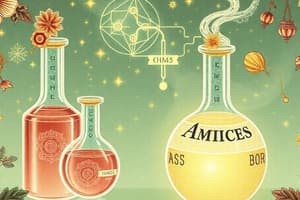Podcast
Questions and Answers
Amines:
Amines:
Organic compounds containing nitrogen atoms
Classification of amines
Classification of amines
Classification in hybridization: 1° called amino. 2° called Imino, 3° called tertiary amine. 2° & 3° further into symmetrical ( having same alkyl/ aryl groups connected ) and unsymmetrical ( diff groups connected to N atom )
Explain Mendius Reaction.
Explain Mendius Reaction.
(1) involves Reduction of alkyl cyanides. (2) 1° amines obtained by reduction of alkyl cyanide with sodium and ethanol. This is mendius Reaction.
Explain Hoffman's Bromamide Degradation.
Explain Hoffman's Bromamide Degradation.
Which amide does produce ethanamine by Hoffman's Bromamide Degradation reaction?
Which amide does produce ethanamine by Hoffman's Bromamide Degradation reaction?
Reaction to covert acetic acid into methylamine
Reaction to covert acetic acid into methylamine
Describe an addition reaction in organic chemistry.
Describe an addition reaction in organic chemistry.
What is a characteristic of aromatic compounds?
What is a characteristic of aromatic compounds?
What process involves breaking down complex molecules into simpler precursors?
What process involves breaking down complex molecules into simpler precursors?
What is the chemical structure of ethanol?
What is the chemical structure of ethanol?
Ammonolysis of alkyl halides ( alkylation of ammonia. )
Ammonolysis of alkyl halides ( alkylation of ammonia. )
Flashcards are hidden until you start studying
Study Notes
Organic Chemistry Overview
- Organic chemistry focuses on carbon-containing compounds, studying their structure, properties, reactions, and synthesis.
- Carbon compounds primarily include hydrogen, oxygen, nitrogen, sulfur, and phosphorus.
Key Concepts
- Functional Groups: Key to determining molecular reactivity and properties, including:
- Hydroxyl (-OH)
- Carbonyl (C=O)
- Carboxyl (-COOH)
- Amino (-NH2)
- Alkyl groups (C-H chains)
Classes of Organic Compounds
-
Alkanes (Saturated Hydrocarbons):
- General formula: CnH2n+2
- Examples include Methane (CH4) and Ethane (C2H6).
-
Alkenes (Unsaturated Hydrocarbons):
- General formula: CnH2n
- Characterized by a carbon-carbon double bond (C=C), e.g., Ethylene (C2H4).
-
Alkynes (Unsaturated Hydrocarbons):
- General formula: CnH2n-2
- Contains at least one carbon-carbon triple bond (C≡C), e.g., Acetylene (C2H2).
-
Aromatics:
- Compounds with aromatic rings that have delocalized π electrons, e.g., Benzene (C6H6).
-
Alcohols:
- Contain hydroxyl (-OH) groups, e.g., Ethanol (C2H5OH).
-
Carboxylic Acids:
- Have a carboxyl (-COOH) group, e.g., Acetic acid (C2H4O2).
-
Esters:
- Formed from alcohol and carboxylic acid reactions, e.g., Ethyl acetate (C4H8O2).
-
Amines:
- Ammonia derivatives, with hydrogen replaced by alkyl or aryl groups, e.g., Ethylamine (C2H7N).
Reaction Types
-
Addition Reactions:
- Atoms/groups added to double/triple bonds in alkenes/alkynes.
-
Substitution Reactions:
- Replacement of one atom/group with another, typical in aromatic compounds.
-
Elimination Reactions:
- Removal of atoms/groups from adjacent carbons, creating double or triple bonds.
-
Rearrangement Reactions:
- Molecular structures reconfigure to form isomers.
Synthesis and Mechanisms
-
Synthetic Strategies:
- Retrosynthetic analysis breaks complex molecules into simpler parts.
- Green chemistry aims to reduce or eliminate hazardous substances in chemical processes.
-
Reaction Mechanisms:
- Detailed transformations of reactants to products featuring intermediates and transition states.
Importance
- Organic chemistry is essential in biology, medicine, and materials science.
- Critical for developing pharmaceuticals, agricultural chemicals, and in biochemistry.
Studying That Suits You
Use AI to generate personalized quizzes and flashcards to suit your learning preferences.



